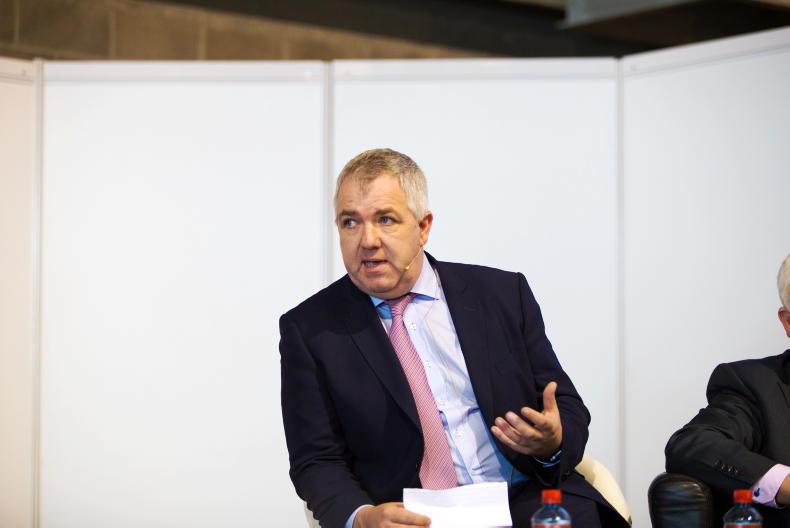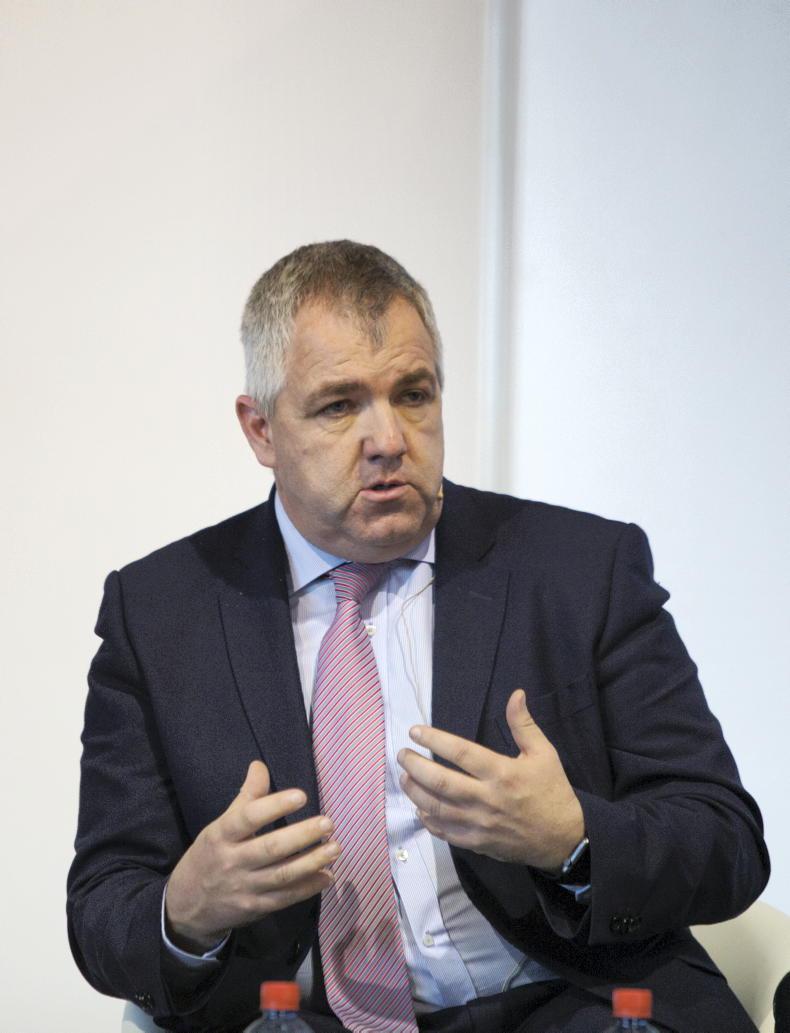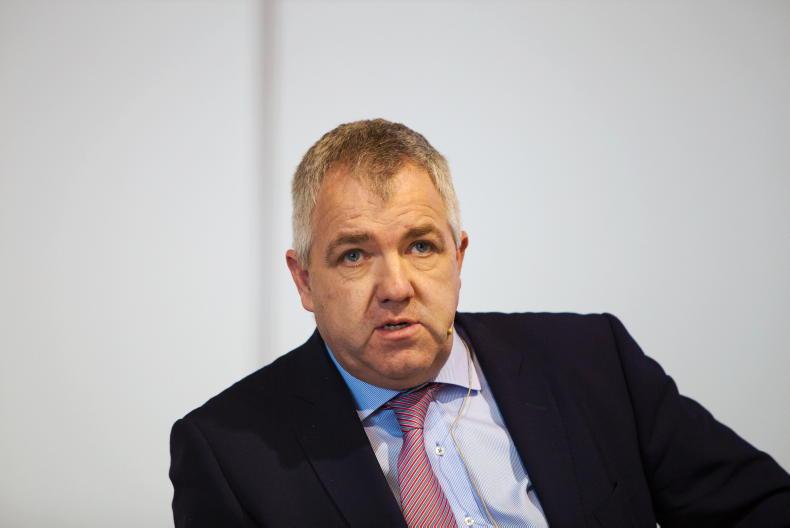JK: James you’re just in the door as chair of Animal Health Ireland (AHI). In the short to medium term, where do you see the one key priority for AHI for 2022?
JL: Jack, I am still becoming familiar with the details of all of the activities within the organisation, and it is difficult to pick just one.
There are obviously big challenges and opportunities ahead based on recent European legislation.
This will mean changes in how we manage antibiotics around drying off and the requirement to move to selective dry cow therapy. The emergence of antiparasitic resistance is another big challenge for farmers, and we have just begun accepting registrations from farmers for a funded veterinary visit, including faecal egg testing.
I would go for bringing the BVD eradication programme to the point where Ireland can apply to the European Union for recognition of freedom
The Department of Agriculture has made provision for up to 40,000 farmers to participate this year, so this will be a major focus over the coming months.
However, if I were to pick one key priority for 2022, I would go for bringing the BVD eradication programme to the point where Ireland can apply to the European Union for recognition of freedom.
Is the BVD timeline still on track? We understand that, currently, the Department is establishing the criteria the EU needs to apply for BVD-free status and the application will be made at the end of 2022?
The BVD Implementation Group collectively introduced a series of programme enhancements in 2021 designed to ensure that herds with evidence of infection are cleared from it and that onward spread to other herds is minimised. We are seeing evidence of the effectiveness of these measures in 2022.
While there is still some way to go this year, these results are very encouraging and put the programme on target to apply for freedom based on the outturn at the end of the year
With over 1.05m calves tested already, the level of both herds and calves with positive results this year has been halved, with 99.99% of calves returning a negative result.
While there is still some way to go this year, these results are very encouraging and put the programme on target to apply for freedom based on the outturn at the end of the year.

James Lynch.
It is important that we all continue to submit tissue tags from all calves as soon as possible after calves are born and to take the necessary measures to prevent accidental introduction of infection into our herds, particularly over the early breeding season when most cows are in the early stages of pregnancy and exposure will lead to the creation of new persistently infected calves.
Cellcheck has seen huge progress in reducing somatic cell count but milk recording and investment in new equipment is crucial to ongoing success as selective dry cow therapy comes more on to the radar. Would you agree? And what do you think needs to happen across the industry to make further progress?
As you say, milk quality has seen a great improvement over the past decade, with national SCC falling from a peak of 272,000 to around 175,000 for the past several years.
There is still room for further improvement, with approximately one-third of herds having an SCC of over 200,000.
In addition to the reduced profitability associated with high SCC, these herds are poorly placed to implement selective dry cow therapy, as required by the new EU legislation.
The information generated by milk recording is crucial to helping these herds improve their milk quality.
The CellCheck Implementation Group has established a series of agreed targets for the industry for 2025
Even for those herds below 200,000, accurate cow level information on SCC across the lactation is vital for making treatment decisions at drying off, and this is again best delivered through milk recording.
The CellCheck Implementation Group has established a series of agreed targets for the industry for 2025, which include both increasing the proportion of herds milk recording to 90% and the number of recordings per year to six, alongside much greater recording of both mastitis and dry cow treatments.
These are challenging targets, but necessary if we are to effectively address the changes in dry cow therapy and avoid a decrease in milk quality at a national level.

The supports provided by processors to encourage adoption have been very beneficial, with an increase in the proportion of herds recording in 2021 to 50% from 44% in 2020, representing 57% and 68% of cows and the average number of recordings per lactation increasing slightly from 4.5 to 4.6.
This progress is encouraging, but still falls short of what is required to reach the targets.
There are no easy solutions, but further progress will require an ongoing communication programme to make farmers aware of the changes in the first instance, highlighting the benefits of milk recording and addressing barriers to adoption and making best use of the information that is generated at farm level to address any milk quality issues and inform treatment decisions at drying off.
Where does the IBR programme within AHI stand at the moment?
Addressing IBR has benefits for both dairy and beef farmers. These are not only economic, but also in terms of the climate challenge, by increasing the efficiency of production, and by reducing the need for antibiotic treatment of sick animals.
In addition, as markets for live exports progress their own programmes, having a programme in Ireland will become increasingly important as one element required to maintaining this trade.
Given the different nature of IBR as compared to BVD, a national programme would take a different approach
AHI, through its IBR technical working group, has been using a newly developed Irish disease model to develop options for a national eradication programme that is aligned with EU legislation.
Given the different nature of IBR as compared to BVD, a national programme would take a different approach. For herds where there is evidence of infection, vaccination would be a key tool to reduce prevalence over time to a point where either the herd is free or only a few carrier animals are left that can be managed out of the herd.
AHI data shows that over three million doses, at an estimated cost of more that €8m, were spent on IBR vaccination in 2020, with sales increasing each year.
On the one hand this is a great start, as it means that many herds are already investing in control, but on the other, these costs will continue indefinitely without a structured programme.
As a first step toward this, the Department has been undertaking twice-yearly national bulk tank surveillance testing for IBR, with some 41% of herds returning a negative result at the most recent round of testing.
The necessary agreements have now been put in place to allow these results to be shared with ICBF and it is intended to use these results to generate tailored communications to herd owners based on their results, beginning later this year.
AHI welcomes the inclusion within the Government’s Climate Action Plan 2021 of the launch of an IBR eradication programme as one of the measures to promote improved efficiency and reduced emissions in livestock via improved animal health and welfare.
Launching a national programme will be a significant undertaking which will require the support of all AHI stakeholders.
JK: James you’re just in the door as chair of Animal Health Ireland (AHI). In the short to medium term, where do you see the one key priority for AHI for 2022?
JL: Jack, I am still becoming familiar with the details of all of the activities within the organisation, and it is difficult to pick just one.
There are obviously big challenges and opportunities ahead based on recent European legislation.
This will mean changes in how we manage antibiotics around drying off and the requirement to move to selective dry cow therapy. The emergence of antiparasitic resistance is another big challenge for farmers, and we have just begun accepting registrations from farmers for a funded veterinary visit, including faecal egg testing.
I would go for bringing the BVD eradication programme to the point where Ireland can apply to the European Union for recognition of freedom
The Department of Agriculture has made provision for up to 40,000 farmers to participate this year, so this will be a major focus over the coming months.
However, if I were to pick one key priority for 2022, I would go for bringing the BVD eradication programme to the point where Ireland can apply to the European Union for recognition of freedom.
Is the BVD timeline still on track? We understand that, currently, the Department is establishing the criteria the EU needs to apply for BVD-free status and the application will be made at the end of 2022?
The BVD Implementation Group collectively introduced a series of programme enhancements in 2021 designed to ensure that herds with evidence of infection are cleared from it and that onward spread to other herds is minimised. We are seeing evidence of the effectiveness of these measures in 2022.
While there is still some way to go this year, these results are very encouraging and put the programme on target to apply for freedom based on the outturn at the end of the year
With over 1.05m calves tested already, the level of both herds and calves with positive results this year has been halved, with 99.99% of calves returning a negative result.
While there is still some way to go this year, these results are very encouraging and put the programme on target to apply for freedom based on the outturn at the end of the year.

James Lynch.
It is important that we all continue to submit tissue tags from all calves as soon as possible after calves are born and to take the necessary measures to prevent accidental introduction of infection into our herds, particularly over the early breeding season when most cows are in the early stages of pregnancy and exposure will lead to the creation of new persistently infected calves.
Cellcheck has seen huge progress in reducing somatic cell count but milk recording and investment in new equipment is crucial to ongoing success as selective dry cow therapy comes more on to the radar. Would you agree? And what do you think needs to happen across the industry to make further progress?
As you say, milk quality has seen a great improvement over the past decade, with national SCC falling from a peak of 272,000 to around 175,000 for the past several years.
There is still room for further improvement, with approximately one-third of herds having an SCC of over 200,000.
In addition to the reduced profitability associated with high SCC, these herds are poorly placed to implement selective dry cow therapy, as required by the new EU legislation.
The information generated by milk recording is crucial to helping these herds improve their milk quality.
The CellCheck Implementation Group has established a series of agreed targets for the industry for 2025
Even for those herds below 200,000, accurate cow level information on SCC across the lactation is vital for making treatment decisions at drying off, and this is again best delivered through milk recording.
The CellCheck Implementation Group has established a series of agreed targets for the industry for 2025, which include both increasing the proportion of herds milk recording to 90% and the number of recordings per year to six, alongside much greater recording of both mastitis and dry cow treatments.
These are challenging targets, but necessary if we are to effectively address the changes in dry cow therapy and avoid a decrease in milk quality at a national level.

The supports provided by processors to encourage adoption have been very beneficial, with an increase in the proportion of herds recording in 2021 to 50% from 44% in 2020, representing 57% and 68% of cows and the average number of recordings per lactation increasing slightly from 4.5 to 4.6.
This progress is encouraging, but still falls short of what is required to reach the targets.
There are no easy solutions, but further progress will require an ongoing communication programme to make farmers aware of the changes in the first instance, highlighting the benefits of milk recording and addressing barriers to adoption and making best use of the information that is generated at farm level to address any milk quality issues and inform treatment decisions at drying off.
Where does the IBR programme within AHI stand at the moment?
Addressing IBR has benefits for both dairy and beef farmers. These are not only economic, but also in terms of the climate challenge, by increasing the efficiency of production, and by reducing the need for antibiotic treatment of sick animals.
In addition, as markets for live exports progress their own programmes, having a programme in Ireland will become increasingly important as one element required to maintaining this trade.
Given the different nature of IBR as compared to BVD, a national programme would take a different approach
AHI, through its IBR technical working group, has been using a newly developed Irish disease model to develop options for a national eradication programme that is aligned with EU legislation.
Given the different nature of IBR as compared to BVD, a national programme would take a different approach. For herds where there is evidence of infection, vaccination would be a key tool to reduce prevalence over time to a point where either the herd is free or only a few carrier animals are left that can be managed out of the herd.
AHI data shows that over three million doses, at an estimated cost of more that €8m, were spent on IBR vaccination in 2020, with sales increasing each year.
On the one hand this is a great start, as it means that many herds are already investing in control, but on the other, these costs will continue indefinitely without a structured programme.
As a first step toward this, the Department has been undertaking twice-yearly national bulk tank surveillance testing for IBR, with some 41% of herds returning a negative result at the most recent round of testing.
The necessary agreements have now been put in place to allow these results to be shared with ICBF and it is intended to use these results to generate tailored communications to herd owners based on their results, beginning later this year.
AHI welcomes the inclusion within the Government’s Climate Action Plan 2021 of the launch of an IBR eradication programme as one of the measures to promote improved efficiency and reduced emissions in livestock via improved animal health and welfare.
Launching a national programme will be a significant undertaking which will require the support of all AHI stakeholders.








 This is a subscriber-only article
This is a subscriber-only article










SHARING OPTIONS: